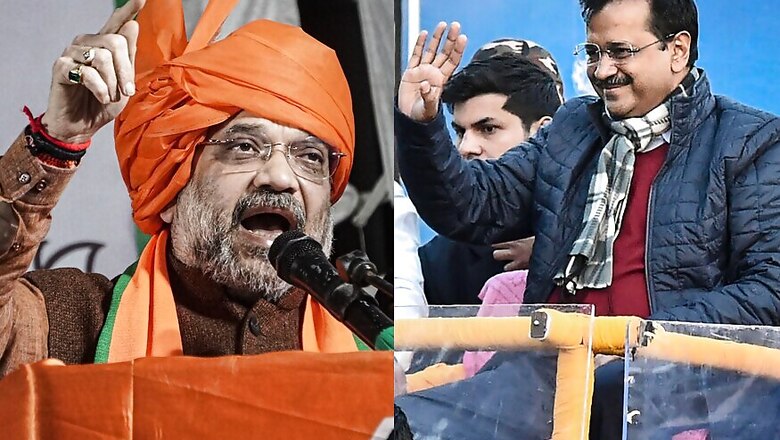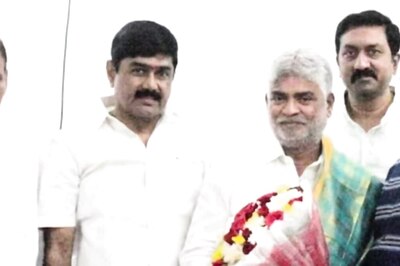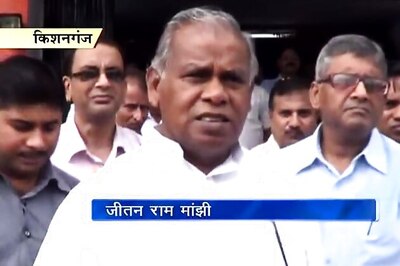
views
New Delhi: Samajwadi Party leader and former telecom minister Beni Prasad Verma quit Samajwadi Party just ahead of the 2009 Lok Sabha polls to join Congress.
He was nominated to contest from Gonda in central UP, a seat once represented by former CM Sucheta Kriplani. Since 1971, the district politics was dominated by Raja Mankapur Anand Singh and his immediate family.
In the 2009 polls, Beni Babu — as he was popularly called in the area — was caught in a four-cornered battle. All three serious candidates against Verma belonged to one caste group — the Rajputs — which are the socially and politically dominant caste in the district.
Mayawati, who was in power in UP, had nominated Anand Singh’s son Kirti Vardhan to challenge Congress’ foray into Gonda.
So Beni Babu — a Kurmi leader in his own right — coined a new slogan for his seat in particular: “ek dabao, teen girao” which roughly translates to “press one button on the voting machine and defeat three from a particular community”.
The messaging was drafted to exploit caste fault lines to polarise all caste groups other against one.
And Beni Babu did manage to win the election on a Congress ticket to become a minister in the Manmohan Singh government.
In electoral politics, slogans are the great disruptors. The effective ones — as history demonstrates — succinctly re-iterate palpable social tensions to make a sense of it all to the electorate.
When Bill Clinton challenged incumbent George Bush senior for US Presidency in 1992, his campaign manager James Carville drafted three slogans for the Democrat candidate: It’s the economy, stupid; Change vs. more of the same and Don’t forget health care.
Of the three, only the first one has survived the test of time. “It’s the economy, stupid” has a nice ring to it; and most importantly, it encapsulates what would have made American people worried in the aftermath of the first Iraq war — that is jobs and economy. If the economy improved, everything else would change, including the health care.
Many people and organisations, including Cambridge Analytica, have attempted to appropriate Donald Trump’s victory in the last US elections.
Scholars have imputed Trump’s success to troll armies operating out of St. Petersburg. Some recent research, however, suggests that despite all this, Trump came up trumps because a) his team made the best and optimum use of digital avenues to reach out to the voters; and b) he could effectively exploit the prevailing social tensions to mobilise support.
His voters were anxious, and were looking for economic stability of the yore. So Trump’s campaign managers borrowed the masthead of their pamphlet from a book titled ‘Taking Our Country Back!’
Ironically, the book authored by American political scientist Daniel Kreiss spoke about how digital affordances were harnessed by former DNC chief Howard Dean and how this exercise catapulted Obama to Presidency in 2009.
Back home, and two decades before Bill Clinton’s first term at White House, Indira Gandhi sought to overcome the challenges both within and outside her party by taking a strident socialistic approach through her policies and programmes.
She brought in a bill to scrap privy-purse guaranteed to erstwhile Rajas of British India and nationalised banks.
‘Garibi Hatao’ was Congress’ slogan for the 1971 Lok Sabha polls. But two slogans that became very popular during the campaign were: “Jat pe na pat pe, Indira ji ki baat pe, Muhar lagegi haath pe”.
Drafted by Hindi poet and former Rajya Sabha MP Srikant Sharma, the refrain was an attempt to build a larger social coalition of the subaltern by subsuming caste identities.
In that election and 1980 after the failed Janata experiment at the Centre, Congress has sought to showcase its ability to provide a stable government by claiming “barson ka nata hei, Sarkar chalana ata hei”.
In the run-up to the 2014 Lok Sabha polls, BJP media strategists set about to finalise their campaign tagline.
Narendra Modi had emerged as the prime ministerial candidate after rigorous political scrutiny and opposition within. Drawing inspiration from Vajpayee’s bid in 1999, the tag line initially drafted was “Abki Baar, BJP Sarkar”.
But a section strongly felt that the votes — as in the case of Vajpayee — were being sought in the name of the PM candidate and not the party. Subsequently, ‘BJP’ in the campaign was replaced with ‘Modi’.
In the ongoing campaign in Delhi, AAP has interestingly tweaked its slogan from ‘Ache beete panch saal’ to ‘Acche honge panch saal, lage raho Kejriwal’.
The change in tack, planned in advance or otherwise, is aimed to make the campaign more forward looking. The best of social sector schemes are no guarantee to favourable electoral outcome. Voters “maange” more, especially in an aspirational cosmopolitan constituency like Delhi.
Secondly, the new tag line also aims to imbue a sense of finality to the campaign; an assurance of sorts that victory is a foregone conclusion. That the future is bright.
An empirical study on Delhi elections in 2013 showed nearly a quarter of the electorate decide their poll preference in the last 36 hours before casting their vote. Political parties understand the vicissitudes of election campaigns.
So watch out for more twists and turns, tweaks and triggers this coming week before voters in Delhi queue up at polling booths to elect a new government.



















Comments
0 comment